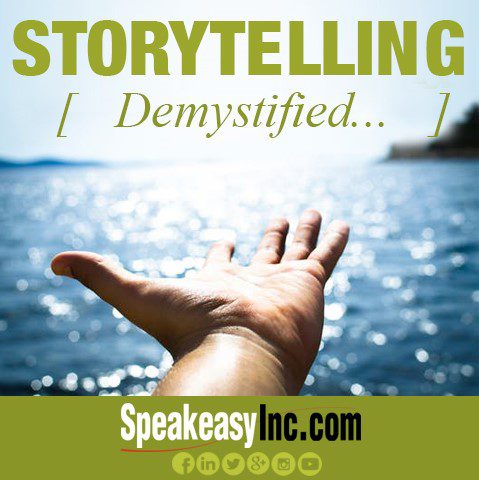
15 Feb Storytelling Demystified
Reading Time: 2 minutesCertain words receive more than their “15 minutes of fame” and storytelling is one we hear a lot. It has become a heavily overused buzzword in the corporate space with a meaning often in the head of the beholder. Clients regularly ask us to help them improve on this skill and to do that successfully, we have to dig deeper to understand what they are really looking to improve.
Over the past decade, we have learned that most of our clients don’t truly mean “storytelling” when they use the word. They aren’t looking for the story-arcs that authors use to organize their books (a literary term) and they don’t mean regaling traditional folk-based oral histories. Rather, they are looking for a way to get their team to stop simply dumping data or information when they communicate and instead, talk about issues in ways that are more relatable and connectable for their audiences.
When pushed, they’ll say things like, “My people have to stop talking only about themselves or just throwing out facts about us. I want them to be able to engage people when they present. They need to be able to tell a story!” Sound familiar? Or from a positive place, “… the other day one of my guys started giving an example of how we helped a client with a similar problem last summer – it was great to see the way that kind of storytelling really lit up the audiences faces.” So, storytelling is often just a jazzy way of saying, “I want to become a more engaging speaker” – exactly what Speakeasy helps people with day in and day out.
Our advice is next time you are in a meeting and hear the infamous buzzword come up as strategy for achieving better sales or motivating a team, use it a conversation starter. Lead a discussion and work to better define what you or the team is looking for when they use the phrase. It can start with something as simple as “You’ve used the word “storytelling” a good bit – what does that actually mean to you?” It’s a great exercise to gain clarity, insert your leadership and prevent a confusing post-meeting plan that’s hard to act on. Because that’s the real enemy, right?
You can help guide the conversation with a few key thoughts…
- Anecdotal stories, with clear morals to take away, are great ways of delivering information when used genuinely and appropriately.
- Supporting your point by delivering a story of past application or benefit in similar circumstances is a great way to make something more real for a listener.
- If using an anecdotal story as part of an opening – retouching on the supportive moral of that story at your close can be a very strong reminder of the value you’re offering.
So yes, if you define “storytelling” as delivering more engaging content when you communicate, you’re on the right track. Just be sure you or your team aren’t derailed by a soft understanding of what that truly means.

